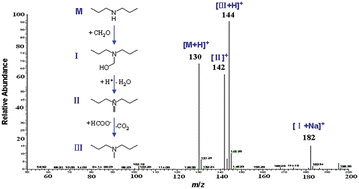Detection of intermediates for the Eschweiler–Clarke reaction by liquid-phase reactive desorption electrospray ionizationmass spectrometry
Abstract

* Corresponding authors
a
Engineering Center for Biomedicine, College of Chemistry and Chemical Engineering, Hunan University, Changsha 410081, China
E-mail:
Yasz@yahoo.com.cn
b
Key Laboratory of Chemical Biology and Traditional Chinese Medicine Research (Ministry of Education of China), Hunan Normal University, Changsha 410081, China
E-mail:
binnguo@126.com
c College of Pharmaceutical Science of Hunan University of Traditional Chinese Medicine, Changsha 410208, China

 Please wait while we load your content...
Something went wrong. Try again?
Please wait while we load your content...
Something went wrong. Try again?
G. Xu, B. Chen, B. Guo, D. He and S. Yao, Analyst, 2011, 136, 2385 DOI: 10.1039/C0AN00879F
To request permission to reproduce material from this article, please go to the Copyright Clearance Center request page.
If you are an author contributing to an RSC publication, you do not need to request permission provided correct acknowledgement is given.
If you are the author of this article, you do not need to request permission to reproduce figures and diagrams provided correct acknowledgement is given. If you want to reproduce the whole article in a third-party publication (excluding your thesis/dissertation for which permission is not required) please go to the Copyright Clearance Center request page.
Read more about how to correctly acknowledge RSC content.
 Fetching data from CrossRef.
Fetching data from CrossRef.
This may take some time to load.
Loading related content
